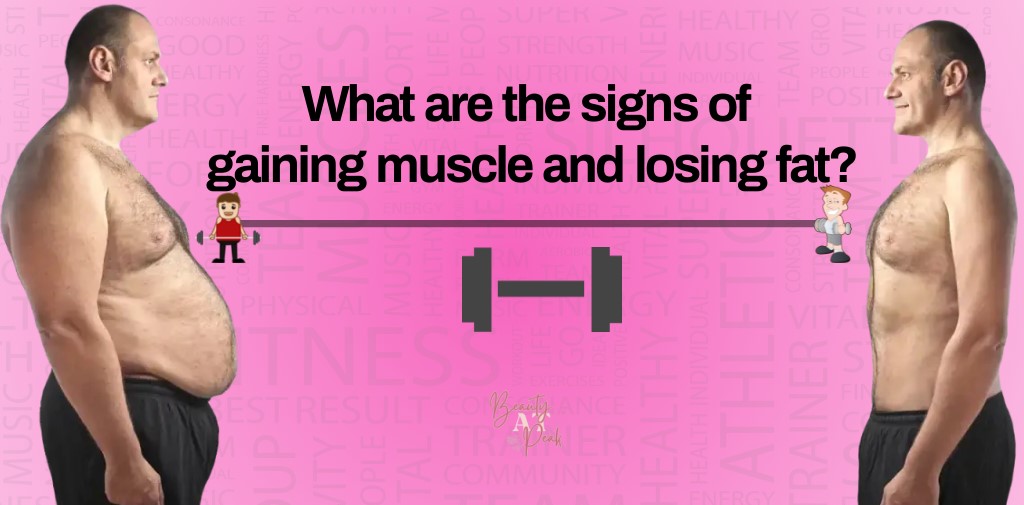When taking off on a fitness journey, it is common to aim for both muscle gain and fat loss. But how do you know if your efforts are paying off? Are there specific markers of muscle gain and fat loss? In the following sections, we’ll look at the signs that indicate progress on this transforming journey.
Do signs of gaining muscle and losing fat in men and women are different ?
Before diving into specifics, it’s crucial to address a common query: do the signs of gaining muscle and losing fat differ between men and women? While the overarching principles remain consistent, there are nuances in how these changes manifest due to variations in physiology and hormonal profiles

Let’s Discuss the signs of gaining muscle and losing fat in male and female
Signs of Gaining Muscle: Female Perspective
For women, gaining muscle often comes with a noticeable increase in strength and definition. You may observe enhanced muscle tone, particularly in areas like the arms, legs, and glutes. Clothes might fit differently as your body becomes more sculpted, and you might even notice a slight increase in weight due to muscle mass, despite a decrease in body fat percentage.
Signs of Gaining Muscle: Male Perspective
Similarly, men experience visible signs of muscle gain through enhanced definition and increased strength. You might notice broader shoulders, a more pronounced chest, and a defined abdomen. As muscle mass increases, you may also observe a slight uptick in weight on the scale, accompanied by improved performance in weightlifting and other physical activities.
Is it Possible to Lose Fat and Gain Muscle Simultaneously?

Contrary to popular belief, simultaneous fat loss and muscle gain—often termed “body recomposition”—are indeed achievable, albeit challenging. This process requires meticulous attention to nutrition, incorporating both a caloric deficit to facilitate fat loss and sufficient protein intake to support muscle growth. Consistent strength training further accelerates progress by stimulating muscle synthesis and metabolic activity.
How to lose fat while gaining muscle?
Achieving the delicate balance of shedding fat while building muscle necessitates a multifaceted approach.

- Start by optimizing your diet, focusing on whole, nutrient-dense foods while moderating calorie intake to create a slight deficit. Prioritize protein-rich sources to support muscle repair and growth, complemented by complex carbohydrates and healthy fats for sustained energy.
- Incorporate strength training into your fitness regimen, emphasizing compound exercises that engage multiple muscle groups simultaneously. Aim for progressive overload by gradually increasing the intensity or volume of your workouts to stimulate muscle adaptation. Supplement your training with cardiovascular exercise to enhance calorie expenditure and promote cardiovascular health.
- Consistency is key; prioritize regular exercise and adherence to your nutrition plan while allowing for adequate rest and recovery. Remember, sustainable progress takes time and patience—celebrate small victories along the way and stay committed to your long-term goals.
Also Read: DOES HONEY AND SALT PRE WORKOUT WORKS ?
Signs of Gaining Muscle and Losing Fat
As you embark on your fitness journey, keep an eye out for these telltale signs of progress:
1. Improved Strength: substantial improvements in your ability to lift larger weights or do difficult activities provide muscular growth.
2. Enhanced Definition: As body fat decreases, muscle definition becomes more pronounced, resulting in a leaner, more sculpted physique.
3. Changes in Clothing Fit: You may find that clothes fit differently as your body composition shifts, with garments feeling snugger around muscles and looser around areas where fat is reduced.
4. Increased Energy Levels: Building muscle and losing fat often coincides with enhanced energy levels and overall vitality, reflecting improvements in physical fitness and metabolic function.
5. Positive Changes in Body Composition: Regular measurements or visual assessments can reveal changes in body composition, including reductions in body fat percentage and increases in lean muscle mass.
Additional Factors to Achieve Optimal Results in losing fat and gaining muscle
FAQs
1. How much water weight do you lose before you start losing fat?
While initial weight loss may include fluctuations in water weight, significant fat loss typically becomes evident after consistently adhering to a balanced diet and exercise regimen for several weeks. Individual factors such as hydration levels and dietary habits can influence the rate of water weight loss.
2. What vitamins are good for losing belly fat?
While no single vitamin can directly target belly fat, certain nutrients such as vitamin D, calcium, and omega3 fatty acids may support overall weight loss and metabolic health. However, incorporating these vitamins into a wellrounded diet alongside regular exercise is key for achieving sustainable fat loss.
3. Can you gain muscle without gaining weight?
Yes, it’s possible to gain muscle without a significant increase in overall body weight, particularly for individuals who are concurrently losing fat. This process, known as body recomposition, involves building muscle while simultaneously reducing body fat percentage through a combination of strength training and proper nutrition.
4. How long does it take to see results from strength training?
The timeline for seeing results from strength training varies depending on factors such as individual fitness level, consistency of training, and nutrition.
5. Is it necessary to lift heavy weights to build muscle?
While lifting heavier weights can stimulate muscle growth, muscle hypertrophy can also be achieved through various resistance training methods, including bodyweight exercises and lighter weights performed at higher repetitions. The key is to consistently challenge your muscles with progressively increasing resistance to promote adaptation and growth.







